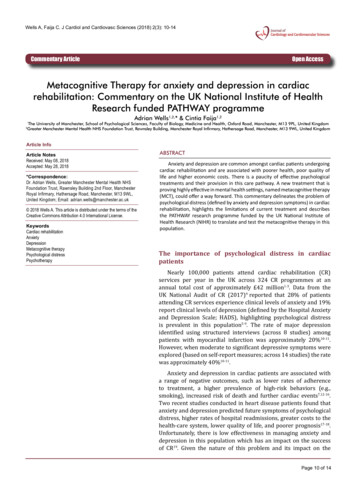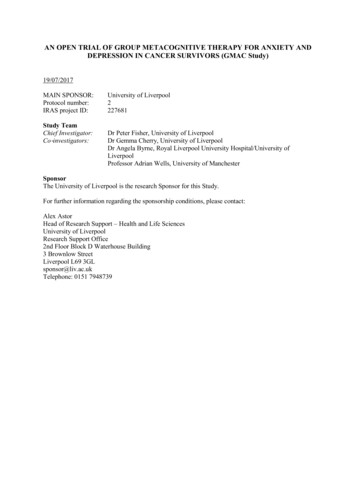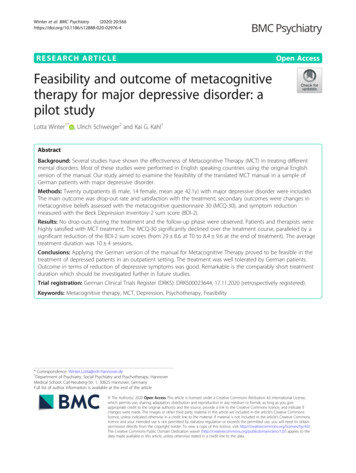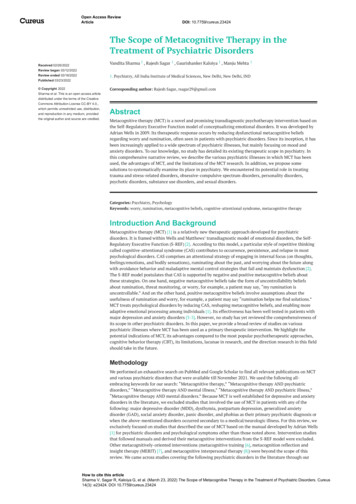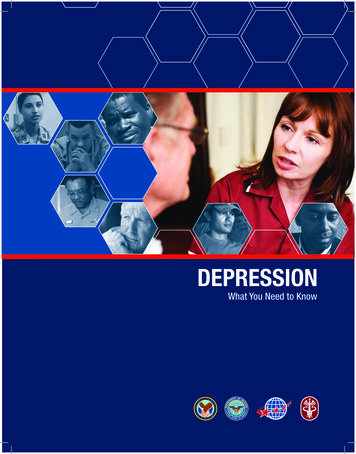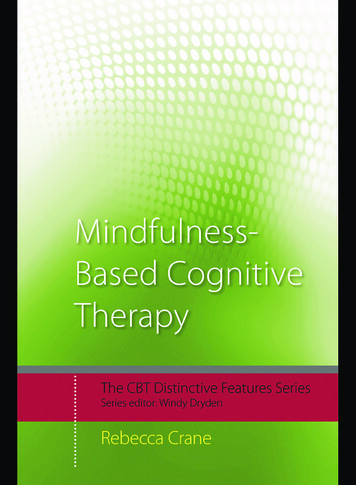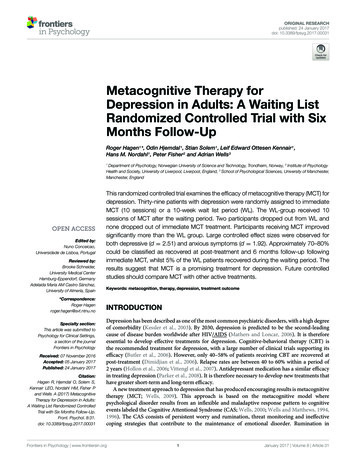
Transcription
ORIGINAL RESEARCHpublished: 24 January 2017doi: 10.3389/fpsyg.2017.00031Metacognitive Therapy forDepression in Adults: A Waiting ListRandomized Controlled Trial with SixMonths Follow-UpRoger Hagen 1*, Odin Hjemdal 1 , Stian Solem 1 , Leif Edward Ottesen Kennair 1 ,Hans M. Nordahl 1 , Peter Fisher 2 and Adrian Wells 31Department of Psychology, Norwegian University of Science and Technology, Trondheim, Norway, 2 Institute of PsychologyHealth and Society, University of Liverpool, Liverpool, England, 3 School of Psychological Sciences, University of Manchester,Manchester, EnglandEdited by:Nuno Conceicao,Universidade de Lisboa, PortugalReviewed by:Brooke Schneider,University Medical CenterHamburg-Eppendorf, GermanyAdelaida María AM Castro Sánchez,University of Almería, Spain*Correspondence:Roger Hagenroger.hagen@svt.ntnu.noSpecialty section:This article was submitted toPsychology for Clinical Settings,a section of the journalFrontiers in PsychologyReceived: 07 November 2016Accepted: 05 January 2017Published: 24 January 2017Citation:Hagen R, Hjemdal O, Solem S,Kennair LEO, Nordahl HM, Fisher Pand Wells A (2017) MetacognitiveTherapy for Depression in Adults:A Waiting List Randomized ControlledTrial with Six Months Follow-Up.Front. Psychol. 8:31.doi: 10.3389/fpsyg.2017.00031This randomized controlled trial examines the efficacy of metacognitive therapy (MCT) fordepression. Thirty-nine patients with depression were randomly assigned to immediateMCT (10 sessions) or a 10-week wait list period (WL). The WL-group received 10sessions of MCT after the waiting period. Two participants dropped out from WL andnone dropped out of immediate MCT treatment. Participants receiving MCT improvedsignificantly more than the WL group. Large controlled effect sizes were observed forboth depressive (d 2.51) and anxious symptoms (d 1.92). Approximately 70–80%could be classified as recovered at post-treatment and 6 months follow-up followingimmediate MCT, whilst 5% of the WL patients recovered during the waiting period. Theresults suggest that MCT is a promising treatment for depression. Future controlledstudies should compare MCT with other active treatments.Keywords: metacognition, therapy, depression, treatment outcomeINTRODUCTIONDepression has been described as one of the most common psychiatric disorders, with a high degreeof comorbidity (Kessler et al., 2003). By 2030, depression is predicted to be the second-leadingcause of disease burden worldwide after HIV/AIDS (Mathers and Loncar, 2006). It is thereforeessential to develop effective treatments for depression. Cognitive-behavioral therapy (CBT) isthe recommended treatment for depression, with a large number of clinical trials supporting itsefficacy (Butler et al., 2006). However, only 40–58% of patients receiving CBT are recovered atpost-treatment (Dimidjian et al., 2006). Relapse rates are between 40 to 60% within a period of2 years (Hollon et al., 2006; Vittengl et al., 2007). Antidepressant medication has a similar efficacyin treating depression (Parker et al., 2008). It is therefore necessary to develop new treatments thathave greater short-term and long-term efficacy.A new treatment approach to depression that has produced encouraging results is metacognitivetherapy (MCT; Wells, 2009). This approach is based on the metacognitive model wherepsychological disorder results from an inflexible and maladaptive response pattern to cognitiveevents labeled the Cognitive Attentional Syndrome (CAS; Wells, 2000; Wells and Matthews, 1994,1996). The CAS consists of persistent worry and rumination, threat monitoring and ineffectivecoping strategies that contribute to the maintenance of emotional disorder. Rumination inFrontiers in Psychology www.frontiersin.org1January 2017 Volume 8 Article 31
Hagen et al.MCT for Depressionstudy. Within-group effect size for depression trials in thereview was 2.18 (Hedges g) at post-treatment. However, only theNordahl (2009) study was a randomized trial and the primaryproblem was not exclusively depression. A previous study onMCT for depression was not included in the review: Wells et al.(2009) described MCT for four depressed patients of which threewere recovered at 6 months follow-up. Recovery in the Wellsstudy (2009) was defined using Frank et al.’s (1991) criteria,consisting of no longer having a diagnosis of depression anda Beck Depression Inventory (BDI) score of 8 or less. Sincethe publication of the review of Normann et al. (2014), severalstudies on MCT for depression have been published (Jordan et al.,2014; Callesen et al., 2015; Dammen et al., 2015; Papageorgiouand Wells, 2015). These studies also used Frank et al.’s (1991)criteria. The study by Callesen et al. (2015) described thetreatment of four depressed patients of which three of themwere recovered. The group-MCT study by Dammen et al. (2015)reported that 91% of the patients recovered at follow-up. Anothergroup-MCT study (Papageorgiou and Wells, 2015) included 10antidepressant and CBT resistant depression patients, and foundthat 70% were recovered at post-treatment and follow-up. Thereported effect size reported with Hedge’s g was 2.88 at endtreatment and 2.50 et 6 months’ follow-up. However, the smallsample size of all these studies limits the generalizability of theseresults.In the only controlled study of MCT in depression, 23depressed patients were treated with MCT and compared with25 patients treated with CBT (Jordan et al., 2014). Jordan et al.(2014) found that MCT and CBT produced similar positiveresults on symptom measures, but MCT produced superioreffects on improved executive control (Groves et al., 2015).The reported effect sizes using Cohen’s d for intention to treatwere 1.12 for MCT at end treatment. However, there werelimitations in this study including low power, greater comorbidityin the MCT condition, and a lack of formal therapist trainingin MCT.In summary, current recommended approaches fordepression are CBT and antidepressant medication whichproduce moderate success rates and are often associated withsignificant relapse or recurrence. The metacognitive approachoffers promising opportunities for addressing these limitationsof treatment by directly targeting rumination and its underlyingmechanisms that are seen as essential in the developmentand maintenance of depression (Wells, 2009). The presentrandomized controlled trial includes a larger sample of patientstreated with MCT, and metacognitive therapist competencywas ensured through training and supervision. We comparedMCT with a waiting list control, since treatment studies donot take into account spontaneous remission in depression,as demonstrated by a mean decrease of 10–15% in depressivesymptoms for waiting list control groups (Posternak andMiller, 2001). Furthermore, a WL condition can providecontrol over the effects of repeated assessment, regressionto the mean and the expectancy of receiving treatment (e.g.,optimism). Our prediction was that MCT would lead to greaterimprovement in depressive symptoms than a waiting period of10 weeks.depression is seen as a coping strategy which follows aninitial negative thought labeled a ‘trigger thought’. Thedepressed individual engages in rumination consisting ofrepeatedly analyzing negative feelings, past failures and mistakes.Depression is therefore understood as an extension of lowmood resulting from a problem of overthinking (e.g., worryand rumination) and withdrawal of active coping. (e.g., socialwithdrawal and reduction in activity). According to themetacognitive model of depression, rumination and worry ismaintained by metacognitions and not by changes in moodor events. Further, this response to triggers extends negativethinking, leads to reduced attentional flexibility and involvesa failure to exercise appropriate control over negative affectiveexperiences (Wells, 2009).According to the metacognitive model metacognitive beliefscontrol, monitor and appraise the CAS (Wells, 2009). Thereare both positive and negative metacognitive beliefs. Positivemetacognitions are concerned with the benefits of worryand rumination, while negative metacognitions are concernedwith the uncontrollability and danger of thoughts. Positivemetacognitions related to depression may be exemplified bystatements like: “Analyzing the causes of my sadness will giveme an answer to the problem”, and “Thinking the worstwill make me snap out of it”. Such positive metacognitivebeliefs lead to repeated and/or prolonged engagement inruminative thinking. Negative metacognitions are activated asthe rumination process leads to distress and/or as a resultof what the individual learns about depression. Examples ofnegative metacognitions are: “I can’t control my thinking”, “Mythoughts are caused by my defective brain”, “Sleeping morewill sort out my mind”. and “Thinking like this means I couldhave a mental breakdown”. Negative metacognitions lead tomore distress and to unhelpful behaviors that reduce effectivecoping.Metacognitive therapy aims to eliminate the CAS andto modify erroneous metacognitive beliefs to enable thedevelopment of greater flexible reactions to negative internalevents. It does so by using behavioral experiments andverbal reattribution (Wells and Matthews, 1996; Wells, 2009),targeted at metacognitive change and specific techniques suchas the attention training technique, detached mindfulnessand postponement of rumination. According to metacogntivetherapy this will enhance flexible executive control, andthrough the process of therapy the patient learns new andmore beneficial ways of relating to thoughts that act astriggers for rumination (Wells, 2009). To clarify the differencesbetween CBT and MCT; CBT focus on the content ofthoughts and invites the patient to reality test this content,while in MCT thinking processes are addressed (for furtherdescriptions of differences and similarities confer Fisher andWells, 2009).A recent meta-analysis of MCT for anxiety and depressionconcluded that MCT is effective and superior to waiting list andpossibly CBT (Normann et al., 2014). The review by Normannet al. (2014) included two treatment studies on depression(Nordahl, 2009; Wells et al., 2012), one postpartum depressionstudy (Bevan et al., 2013) as well as results from an unpublishedFrontiers in Psychology www.frontiersin.org2January 2017 Volume 8 Article 31
Hagen et al.MCT for Depressionas primary diagnosis (n 18), other primary diagnosis (n 16),cluster A or B personality disorder (n 10), no psychiatricdiagnosis (n 8), subclinical depression (n 5), social phobiaas primary diagnosis (n 4), somatic diseases (n 2), PTSD(n 1), substance dependence (n 1), and one patient wasexcluded due to use of anti-psychotic medication.Participants were recruited between January 2013 and January2015. Participants were treatment-seeking individuals referredby their GP or self-referred to a university outpatient clinicin a major city in Norway. Information about the study anddescriptions of how to refer participants were provided inMATERIALS AND METHODSParticipantsThe total sample consisted of thirty-nine participants andincluded 59% women (n 23). The majority were ethnicNorwegians and three were Asian. The mean age was 33.7 yearswith a range from 18 to 54. Average number of children was1.2. Three participants were currently treated with SSRIs. Theywere included as long as they agreed to maintain a stabledosage throughout the trial. A total of 30 (76.9%) participantshad received earlier treatment for depression from their generalpractitioner, nine (23.1%) reported having been medicated withSSRIs for depression, 21 (53.8%) had received treatment frompsychologists/psychiatrists at psychiatric outpatient clinics, three(7.7%) had previous inpatient treatment stays, and one hadundergone ECT treatment.A total of 16 participants were single, 15 were married orcohabitants, five had romantic partners, and three were divorcedor separated. In all 12 patients worked full time, eight worked parttime, seven were full time students, one was a part time student,while 13 were unemployed or received social or welfare benefits.With respect to education, two had completed elementary school,17 had completed high school, five had 3 year college educations,and 15 had a 5 year university degree. Further demographicinformation on the sample is displayed in Table 1.Most of the sample had a recurrent depression diagnosis(79.5%) while 20.5% had a current depressive episode. Themean age at which the first depressive episode occurred was26.2 years (SD 11.7). The average duration of depressionwas M 7.6 years (SD 7.1). Comorbidity within thesample was as follows: 16 patients had one additional axis-Idisorder (10 generalized anxiety disorder, two panic disorder, onesocial phobia, one hypochondriasis, one trichotillomania, andone eating disorder not otherwise specified), one patient alsohad a second comorbid axis-I disorder (binge-eating disorder).A total of 13 patients also had comorbid axis-II disorders (threeavoidant personality and 10 obsessive compulsive personalitydisorders). Thirteen patients (33.3%) had depression as theirsingle diagnosis.TABLE 1 Demographic and diagnostic information (N 39).WLNTotal pre192039M (SD)M (SD)M (SD)35.4 (8.8)32.2 (11.7)33.7 (10.4)% (n)% (n)% (n)52.6 (10)65.0 (13)59.0 (19)Norwegian ethnicity100.0 (19)85.0 (17)92.3 (36)Married/cohabitant42.2 (8)35.0 (7)38.5 (15)College/univ. degree57.9 (11)45.0 (9)51.3 (20)Full time employed42.1 (8)20.0 (4)30.8 (12)Part time employed15.8 (3)25.0 (5)20.5 (8)Full time student15.8 (3)20.0 (4)17.9 (7)Part time student0.0 (0)5.0 (1)5.0 (1)26.3 (5)40.0 (8)33.3 (13)SSRIs current use5.3 (1)10.0 (2)7.7 (3)SSRIs previous use15.8 (3)30.0 (6)23.1 (9)GP treatment84.2 (16)70.0 (14)76.9 (30)Psychiatric outpatient63.2 (12)45.0 (9)53.8 (21)AgeWomenSocial/welfare benefitsTotal postDepressive episodeMild0000Moderate1231Major1230Recurrent depressionMild1013111021056110GAD55102Social phobia1011Hypochondriasis1010Panic disorder1120EDNOS0110Binge eating 1OCPD55107Total67138ModerateMajorProcedureAxis I comorbidityThis trial was registered at ClinicalTrials.gov (NCT01608399),and it was approved by the Regional Medical Ethics Committeein Norway (ref.nr. 2011/1138). Patients with primary depressiondisorder (mild, moderate, or severe) either single episode orrecurrent depression were included (DSM-IV criteria). Furtherinclusion criteria for the study were signed written informedconsent, and 18 years or older. Exclusion criteria were (a) knownsomatic diseases, (b) psychosis, (c) current suicide intent, (d)PTSD, (e) cluster A or cluster B personality disorder, (f) substancedependence, (g) not willing to accept random allocation, (h)patients not willing to withdraw use of benzodiazepines fora period of 4 weeks prior to entry to the trial, and (i)patients undergoing concurrent therapy elsewhere. A total of 105diagnostic interviews were completed out of which 66 patientswere excluded from the study. Reasons for exclusions were: GADFrontiers in Psychology www.frontiersin.orgMCTTotalAxis II comorbidityEDNOS Eating Disorder Not Otherwise Specified, GAD generalized anxietydisorder, Avoidant avoidant personality disorder, OCPD obsessive compulsivepersonality disorder, GP general practitioner.3January 2017 Volume 8 Article 31
Hagen et al.MCT for Depressioncategorized the BDI total scores as follows: 0–9 minimal, 10–18mild, 19–29 moderate, and 30–63 severe depression.The Beck Anxiety Inventory (BAI; Beck and Steer, 1990) isa 21-item self-report inventory for assessing the presence andseverity of anxiety symptoms. Each item is rated on a four-pointLikert-type scale ranging from 0 to 3, indicating the severity ofeach symptom. Beck and Steer (1990) categorized the BAI totalscores as follows: 0–7 minimal, 8–15 mild, 16–25 moderate, and26–63 severe. For psychometric properties of the BAI, see Steeret al. (1993).local newspapers, as letters to GPs, on the radio and throughadvertisements on social media.After initial telephone screenings, potential participants metwith a trained assessor who provided detailed informationabout the study, obtained informed consent and reviewedinclusion and exclusion criteria and severity of depression andother psychiatric conditions. The diagnostic interviews includedStructured Clinical Interview for the DSM IV axis I (SCID-I; Firstet al., 2002), Structured Clinical Interview for the DSM IV axisII (SCID-II, First et al., 1997), and the Hamilton Rating Scalefor Depression (HRSD-17; Hamilton, 1967). The assessmentteam conducted the interviews at pre- and post-treatment, whilepost-waiting list and follow-up data was based on self-report.Agreement upon diagnosis was achieved by conferring withtwo senior researchers who watched videotaped recordings ofthe interviews. Assessments were completed before treatment,after the wait period (waiting list group only), after treatment,and at 6 months follow-up. Consenting participants who metinclusion criteria were randomly assigned to either begin MCTimmediately or after a 10-week wait period.Sample size was calculated based on a minimum clinicallymeaningful difference between treatments on BDI of 7. Acceptinga probability of Type I error of 5 per cent with 80 percentpower (Chandrashekara, 2012), 17 patients would be required ineach group. Estimating with an expected attrition rate of 30%would indicate group sizes of 22. Given that the attrition ratewas low, inclusion was stopped at 39 patients. A randomizationschedule was generated by Excel’s random number generatorprior to the project start. Two factors were controlled for inthe randomization; gender and recurrent depressive episodes.Figure 1 illustrates participant flow through the study.TreatmentPatients received 10 sessions of MCT for depression followingthe published treatment manual and session guides fordepression (Wells, 2009). Briefly, the treatment consisted of:case conceptualization and socialization which are undertakenfirst and then followed by (1) increasing meta-awarenessby identifying thoughts that act as triggers for rumination,learning about metacognitive control using attention training;(2) challenging beliefs about the uncontrollability of ruminationand worry; (3) challenging beliefs about threat monitoring anddangers of rumination and worry; (4) modification of positivebeliefs about rumination and worry; and (5) relapse prevention.TherapistsTherapists were clinical psychologists who had all receivedprevious training in MCT. Treatment was supervised byprofessor Adrian Wells (AW), the originator of MCT, to ensurequality of the delivered treatment. AW watched videotapedrecordings of sessions and provided ongoing feedback. Thetapes were simultaneously translated by the bilingual therapists.The therapists met every month for peer supervision. Noformal measure of therapists’ competence, treatment integrityor adherence was obtained. A split plot ANOVA found nosignificant differences between therapists with respect to changesin HRSD scores, F(3,34) 0.942, p 0.43).MeasuresStructured Clinical InterviewsStructured clinical interviews were performed both at pre- andat post-treatment with the SCID-I and SCID-II and theHRSD17. Diagnoses were assessed using the SCID-I and SCID-II.The patients were re-assessed with SCID-I and SCID-II atpost-treatment using only the modules corresponding to theirpre-treatment diagnoses. This was to assess if they had thesame diagnosis after having undergone treatment. The HRSD17 is a structured interview that includes items related todepressive symptoms, 0–4 scale, where 0 correspond to theabsence of symptoms, and the score of 4 corresponds to severesymptoms. Scores between 0 and 6 do not indicate the presenceof depression, scores between 7 and 17 indicate mild depression,scores between 18 and 24 indicate moderate depression, andscores over 24 indicate severe depression.Data AnalysesA mixed-model repeated ANOVA was used to compare the MCTgroup with the waiting list control. Partial eta squared statisticsand Cohen’s d effect sizes (using pooled standard deviations)were used to estimate the treatment effects and between groupdifferences. A repeated measures ANOVA and t-tests was alsoused to estimate the treatment effects for the total combinedsample (those who received immediate and delayed treatment),entering BDI and BAI scores from pre-treatment, post-treatment,and 6 months follow-up. Controlled effect sizes were calculated inthe following way: post treatment for immediate MCT minus postwaiting list divided by the pooled standard deviation. To evaluateclinically significant outcomes, Jacobson criteria (Jacobson et al.,1999) was used, with a cut-off point (14) and reliable change index(8.46, which was rounded up to 9 in the present study) obtainedfor the BDI (Seggar et al., 2002). Both ITT and completer analysesare reported on outcome measures and clinically significantchange analyses, thus allowing for comparison with existingstudies as recommended (Hiller et al., 2012).Self-Report InstrumentsThe Beck Depression Inventory (BDI; Beck et al., 1961) is a 21item self-report inventory used to measure level of depressivesymptoms. Each item is rated on a four-point Likert-type scaleranging from 0 to 3, indicating the severity of each symptom.The BDI has been extensively shown to be a reliable and validmeasure of severity of depressive symptoms in both clinical- andnon-clinical populations (Beck et al., 1988). Beck and colleaguesFrontiers in Psychology www.frontiersin.org4January 2017 Volume 8 Article 31
Hagen et al.MCT for DepressionFIGURE 1 Flow chart.For the ITT analysis we used last observation carried forwardto replace missing values. The two dropouts from the waiting listcondition were missing BDI and BAI scores at post-treatmentand follow-up. They were assigned their pre-treatment scores atpost-treatment and follow-up. There was very little missing dataon individual BDI items (0.4%) and BAI items (0.8%). In thesecases missing items were replaced using mean item scores on theremaining items.Frontiers in Psychology www.frontiersin.orgAll participants allocated to receive MCT immediately afterrandomization completed treatment. Two participants allocatedto waiting list dropped out during the waiting period (one movedand one started treatment at a private practice psychologist)and did not provide data after pre-treatment. These two wereincluded in the intent to treat analyses and their post-treatmentresults were replaced using last observation carried forward. Ofthe patients initially allocated to waitlist and then going on to5January 2017 Volume 8 Article 31
Hagen et al.MCT for Depressiondelayed treatment, two of them did not go on to complete all10 treatment sessions. These two patients did not meet with theassessment team for a post-treatment and follow-up interview,however self-report data was available from their latest treatmentsessions and used as post-treatment results. Thus, a total of 17patients completed MCT after first being allocated to waiting listresulting in a total of 35 post-treatment interviews. All except oneof these 35 also completed self-report questionnaires at 6 monthfollow-up.HRSDIn the wait list group the HRSD was only assessed prior towaiting and after the provision of delayed treatment. Therefore,comparison between the waitlist group and MCT is not possible.We ran a repeated measures t-test for the whole sample to assessoverall change in HRSD associated with treatment (ITT analysis,see Table 3). For the entire combined sample the ITT showedlarger effect size of d 2.95.Secondary OutcomesBAIRESULTSA mixed model ANOVA was run to assess the comparativeoutcomes on the BAI measured at pre and post-treatment.Table 2 presents the main effects of time F(1,37) 45.06,p 0.001 and the significant group by time interactionF(1,37) 38.57, p 0.001. The group means indicated that theMCT group showed greater improvement in the BAI scores thanthe wait list group from pre to post. The within subject contrastson a group-wise basis confirmed that both the MCT and the waitlist group improved from pre to post intervention. The withingroup effect size (d) were; MCT 2.09, WL 0.09, with acontrolled effect size of d 1.92.Table 1 presents an overview of demographic and diagnosticinformation for the two groups and the total sample. Thetwo groups were similar on all variables with no statisticallysignificant differences between them at pre-treatment. Withrespect to diagnoses there were a total of 57 axis–I diagnosesgiven at pre-treatment for all the participants. This numberwas reduced to 8 axis-I at post-treatment. Four patients stillhad a diagnosis of depression (3 with mild recurrent depressionand 1 with moderate depressive episode). With respect tocomorbid conditions, 3 patients still suffered from GAD, onefrom social phobia and one from trichotillomania. As for axisII comorbidity, there were 13 diagnoses given at pre-treatmentand 8 at post-treatment, suggesting that 40% also recovered fromtheir personality disorder as assessed by SCID-II.Follow-Up ResultsTo assess the stability of the treatment effects repeated measurest-tests for BDI and BAI were used to determine any significantchanges from post treatment to 6 months follow-up assessments.There were no significant changes within this time periodfor any of the measures (see Table 3). Very large effectsizes were observed on the HRSD-17, BDI and BAI frompre to post treatment. The large effect sizes were somewhatlower from pre to 6 months follow-up with BDI of 2.11and BAI of 1.44 for the intention to treat sample (combinedgroups).Primary OutcomesBDITo assess the comparative outcomes a mixed model ANOVA wasrun on the BDI measured at pre and post treatment. Table 2shows the main effect of time F(1,37) 140.59, p 0.001 and thegroup by time interaction, which was significant F(1,37) 80.05,p 0.001. Inspection of the group means indicated that the MCTgroup showed greater improvement in BDI scores than the waitlist group from pre to post. The within subject contrasts on agroup-wise basis confirmed that both the MCT and the wait listgroup improved from pre to post intervention. The within groupeffect sizes (d) were; MCT 3.50, WL 0.49, with a controlledeffect size of d 2.51.Combined SampleTo provide more accurate estimates of effects for the purposesof future sample size estimates the analyses on the combinedsample of patients from pre to post treatment on HRSD17 and pre, post, and follow-up on BDI and BAI werecalculated. In Table 3 the within subjects t-tests showedTABLE 2 Descriptives and Mixed-model ANOVA results for depression and anxiety symptoms and paired sample t-test for within group comparison forMCT and waiting list, respectively.PrePostBetween MCT-WLWithin-groupnMSDMSDFηp 2dtdMCT2027.856.856.406.84140.59 0.792.5112.68 3.50WL1926.895.6123.897.052.63 0.47MCT2022.6010.253.657.708.03 2.09WL1919.167.9718.427.710.440.09BDIBAI45.06 0.551.92BDI Beck Depression Inventory; BAI Beck Anxiety Inventory; MCT Metacognitive therapy; WL Wait-list. HRSD-17 was not administered at post waiting-list. 0.05, p 0.001. pFrontiers in Psychology www.frontiersin.org6January 2017 Volume 8 Article 31
Hagen et al.MCT for DepressionTABLE 3 Means, standard deviations and effect sizes at pre-treatment, post-treatment and 6 months follow-up for the MCT group and the totalcombined sample with repeated sample t-tests for the Hamilton Rating Scale for Depression and repeated measures ANOVA and repeated samplet-tests for BDI and BAI.Pre-treatmentPost-treatmentMSDMSDMCT ITT19.653.425.35All ITT19.923.585.33All Completers20.293.6627.856.85Follow-upt (pre-post)dMSDt (post-FU)F7.418.45 2.536.5414.59 2.953.564.8716.74 4.816.406.8412.68 8.0319.28 3.137.558.96–0.9076.20 20.91 2.538.219.45–1.74162.34 3.456.518.19–1.75172.75 HRSD-17BDIMCT ITTAll ITTAll Completers25.927.146.6425.697.364.775.75MCT ITT22.6010.253.657.782.086.7510.84–1.9830.90 All ITT20.569.224.847.2215.72 1.987.009.56–1.7797.71 5.0117.23 2.346.008.64–1.77104.47 BAIAll Completers20.839.333.608.025 HRSD-17 Hamilton Rating Scale for Depression; BDI Beck Depression Inventory; BAI Beck Anxiety Inventory; ITT Intention To Treat. p 0.001.and over 69.2% at 6 months follow-up. In the waiting listcondition 2.6% recovered, and 2,6 % were improved duringthe 10 weeks of waiting. No patients deteriorated followingtreatment. No harm or unintended effects were reported orobserved. There were no significant differences for moderateand severe recurrent depression, neither from pre to postχ2 (1) 0.13, p 0.72 nor from pre to follow-up χ2 (1) 0.03,p 0.86 on BDI. There were too few participants withepisodes or mild recurrent depression to include these in theanalyses.significant improvements on HRSD, BDI, and BAI, withhigh effect sizes ranging from 1.98 to 3.13 for the intentionto treat sample and from 2.34 to 4.81 for the treatmentcompleters.Clinically Significant Change AnalysesTable 4 presents an overview of clinical significant change forpatients that did not change, improved, or were classified asrecovered after treatment. None deteriorated at post treatmentor follow-up. For the HRSD-17, the immediate MCT intentionto treat effects showed 75% were classified as recovered, whilefor the entire group with intention to treat more than 82.4%were classified as recovered. According to the criterion set byJacobson and colleagues (1999), the BDI results were similarand indicated that approximately 80% of the MCT intentionto treat sample was recovered at post-treatment and 75% at6 months follow-up. For the entire group in the intention totreat condition over 79.5% were recovered at post treatmentReturn to Work OutcomesAt post-treatment 30.6% had started working or studying, 58.3%were still i
This randomized controlled trial examines the efficacy of metacognitive therapy (MCT) for depression. Thirty-nine patients with depression were randomly assigned to immediate MCT (10 sessions) or a 10-week wait list period (WL). The WL-group received 10 sessions of MCT after the waiting period. Two participants dropped out from WL and

